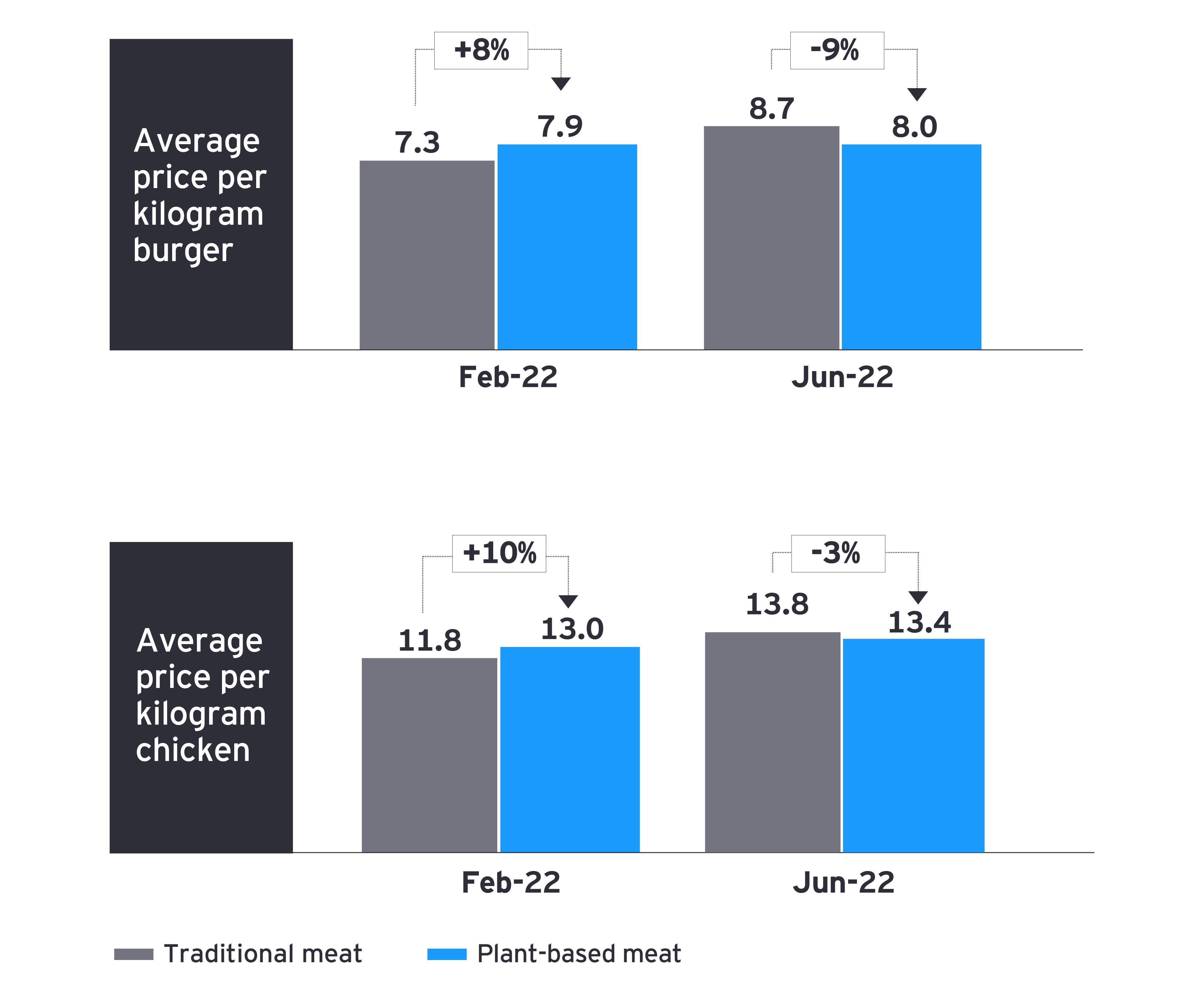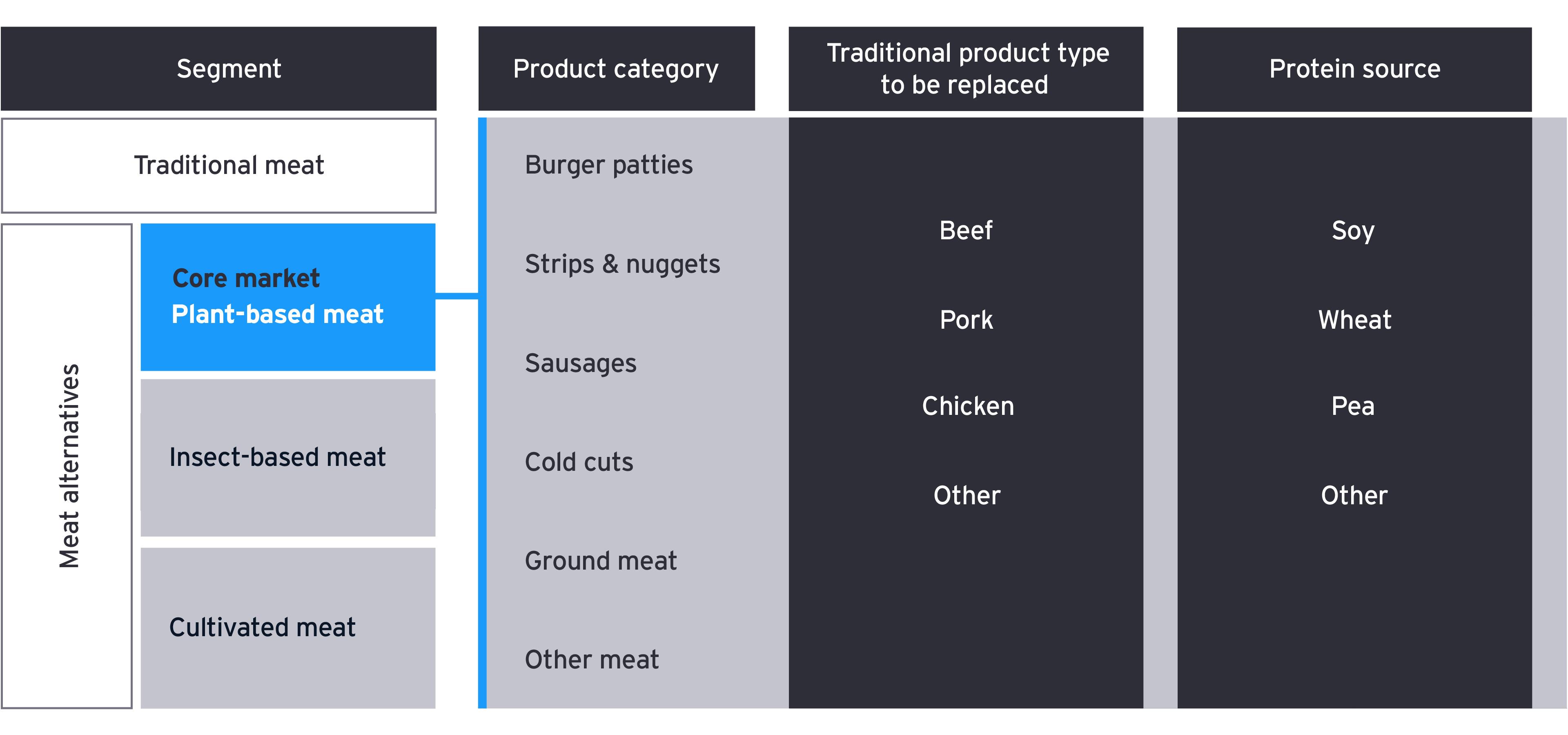
Chapter 1
Reimagined food system on the rise
Key players will need to review their product strategy while taking recent disruptions into account.
While alternative dairy products have experienced strong growth over past years, the alternative meat industry has gained momentum more recently. Many market experts regard the successful development of the alternative dairy category as a showcase for the market potential in the alternative meat segment. The total plant-based food market across all categories could grow explosively to an overall value of over US$162b, according to a recent Bloomberg Intelligence study2. As noted in the EY Food System Reimagined platform3, consumer centricity, planet friendliness and highly connected systems are driving innovations such as alternative proteins.
A reimagined food system is already taking shape – the consumption of alternative proteins is only one example. And although the rapid growth rates and strong performances of start-ups have recently seen a slight dip (mainly because of recent economic disruptions such as increased energy costs inflating prices), the alternative protein industry is expected to develop strongly in the mid to long term.
Market forecast meat consumption by type, US, 2020-2040

Market share outlook for alternative proteins, Germany, 2010-2020

The global food industry is experiencing raw material shortages that might increase in the short term. These shortages have been caused by extreme weather conditions and soil degradations as well as more recently by COVID-19 and war-related supply chain disruptions and fertilizer shortages4, especially in the EU. The complex global supply chain networks in the food industry are highly vulnerable to these disruptions. For meat and alternative meat producers, higher raw material prices are the result as market players compete for more limited supplies. Consequently, consumer prices have increased, and the latest EY Future Consumer Now survey indicates that 80% of consumers expect food prices to continue to increase in the next six months.5
Traditional meat producers are affected more severely by raw material price increases than alternative meat producers, and the green premium that attaches to alternative meat products is likely to be eroded as a result. Due to comparatively lower profit margins and the high and less efficient use of grains in animal feed, meat producers are expected to pass on the higher input prices to the customer. Alternative protein players, on the other hand, are better positioned to absorb price increases. First, they are often less affected by the relatively smaller share of grain input costs along the value chain, although the processing intensity remains high. Second, as their production processes scale and become more efficient, the resulting margin gains can offset some of the negative cost effect. Consequently, we expect consumer prices for traditional meat to increase at a faster rate than those for alternative proteins. Ultimately, this has the potential to decrease the green premium and in turn increase demand for alternative products further.
Green premium: price comparison of meat and plant-based meat products


Chapter 2
Rapid market growth turning the alternative into the new normal
To benefit from increased demand, players need to build resilient supply chains.
Plant-based substitutes represent c. 99% of today’s meat alternatives. Others, such as insect-based, cultivated or lab-grown meat, are still in research or very early stages and commercialized at a small scale only. We don’t foresee lab-grown meat reaching mass market commercialization before the end of the decade. In contrast, we estimate the global plant-based meat market will grow from an estimated US$4.9b1 (less than 1% of the overall meat market) in 2021, to roughly double by 2025. Europe (especially Germany and the UK) represents the largest market for plant-based meat products3, followed by North America and Asia. High growth rates in the plant-based meat segment are the result of favorable developments on both the demand and the supply side, with various drivers:
- Demand drivers: environmental concerns, a lower price premium, animal welfare, focus on personal health and well-being
- Supply drivers: supply chain resilience, capital funding, technological progress, and improved retail positioning
Growth drivers for plant-based meat
Demand-side drivers |
Drivers of plant-based meat |
Supply-side drivers |
||
Environmental |
Increasing awareness of environmental footprint associated with meat consumption | Additonal efforts required to secure grain access | Supply chain resillience |
|
Price premium |
Heightened price - sensitivity due to global inflationary pressure | Financing highly dependent on the sustainability of the business model | Capital funding |
|
Animal welfare |
Growing preference for organic products and alternative protein sources | Rapidly improving quality through high levels of R&D | Technological progress |
|
Personal health and well-being |
Increasing awareness of negative effects from meat-overconsumption on human health | Improved retail positioning through growing brand awareness | Brand positioning |
|
Plant-based meat had been on the rise before the pandemic, which further increased demand in the largely consumer-driven market. Increasing health consciousness as well as eating and cooking at home have prompted consumers to reach for the perceived healthier alternative, driving growth of up to 60% in 2020 and 2021 in certain markets (e.g., Germany and the US). Motivation for plant-based meat consumption differs by country, with Germans being more driven by environmental concerns, while Americans are generally more motivated by individual health concerns. In the long term, we expect more moderate yet still strong growth as plant-based meat replaces traditional meat products, despite the current economic challenges and negative effects of the war in Ukraine on raw material supply. By the 2030s, the percentage of plant-based meat in the overall global meat market should grow toward or beyond 5%-10%.
Because the alternative meat industry relies heavily on plant-based protein, strengthening the supply has become a key lever for maintaining a long-term momentum of growth. Players need to build a resilient and connected supply chain that can address both global and regional disruptions, as well as macro and micro disruptions. A shift toward local production, which is already well underway, can provide some of the required volume and resonates with more sustainability-conscious consumers as well as those seeking fresh, local, and ideally chemical- and preservative-free options. As a result, value creation in the near term will shift toward local production of raw alternative protein inputs. This makes investing in local upstream players attractive not only from a supply chain resilience perspective, but also from a value-capture one.
It’s important that innovation and technology be integrated into operations across the ecosystem. Innovative extraction methods for plant-based protein, for example, enable higher yields and additional value creation. And technologies used to remove operational bottlenecks and help identify new protein sources, ingredients and processes that add taste and nutritional quality to the final product will consistently create value.
Generating further market and consumer demand will also remain important as it drives prices further down, improves taste and variety, and increases international awareness and acceptance.

Chapter 3
Differing market channel dynamics require customized go-to-market
Channel dynamics are driven by end-consumer demand, brand awareness and product innovation.
Due to different market maturities and consumer affinities to plant-based alternatives, channel dynamics for plant-based meat differ significantly between countries. The German market, for example, is strongly dominated by the retail segment (approximately 95%), with out-of-home (OOH) – consuming food in restaurants and other outlets – playing a minor role. Within the retail channel, hypermarkets and supermarkets (57%) hold the strongest position, followed by discounters (31%). The US and China show a different split. US consumption is more balanced between retail and OOH, with some 60% of sales in retail. In China, OOH consumption (approximately 78%) represents the major channel for plant-based meat, and e-commerce and physical retail are just picking up with the introduction of convenience product (e.g., ready-to-eat or ready-to-heat meals).
Plant-based meat market by channel in Germany, US and China in 2020.

The OOH segment has shown strong growth in several European markets, too. Leading fast-food chains have embraced the opportunity and are carrying out significant activities in the promotion of plant-based alternatives and wide-spread offerings. For these chains, introducing the new category offers improved strategic positioning and incremental growth with new customer groups. Leading fast-moving consumer goods (FMCG) brands, as well as authentic independent ones, are benefiting from co-branding activities with fast-food chains. A connected player across the food system can uncover collaborations, improve growth, expand reach and create agility. However, the OOH segment is highly competitive and ultimately a cost game. Collaborating with brands might only be a temporary amplifier for fast-food restaurants on the way to increasing awareness with consumers. In the end, in-house production may be the preferred, more cost-efficient route for restaurants.
The dynamics in the retail segment highly depend on retailer listing decisions; the main drivers behind these decisions are end-consumer demand, brand awareness and product innovation. In Germany, for example, retailers are offering up to 10 different brands of plant-based meat, and all retailers have introduced their own private-label plant-based meat products, following the momentum created by branded products. Even though the willingness to pay for plant-based meat is generally higher than for traditional products, price sensitivity is still expected to lead to a substantial increase in the share of private label products. The growing competition, in addition to the growing shelf space dedicated to plant-based meat, is putting increasing pressure on FMCG players and requiring brands to become more innovative. The effect of the broader variety of available products is driving the need for better supply chain capabilities from brands and retailers alike.

Chapter 4
Tailoring offerings and securing market position
Key players need to reassess their market positioning based on both consumers and the playing field.
The overall competitive landscape in the plant-based meat market is intense and crowded. To be successful, players need to find their positioning based on an understanding of both consumers and the sector playing field. Overall, the key purchasing criteria for plant-based meat are easily named: consumers want taste and freshness as well as products without artificial additives (“clean label”). Meat eaters value taste that is like traditional meat, whereas vegans are looking for organic, animal-free products. As consumers are driving food products more than they ever have, understanding specific consumer preferences, segmenting into distinct groups and having a consumer-centric mindset are prerequisites for any company that wants to have a right to play in the market and differentiate itself from competitors.
Companies seeking new growth opportunities should reassess and optimize their product portfolio, considering three key factors:
Plant-based meat market, segmentation by product categories, type and source

Companies should re-evaluate their product offerings regularly due to changing consumer preferences. A distinct advantage of plant-based players compared to traditional meat producers is their ability to respond to changing preferences far more quickly. In traditional beef, for example, it would take about two years to create a “new” product formulation. Plant-based producers can be far more agile. In addition to choosing a specific product offering, players position themselves through their pricing strategy, packaging and branding as well as their assortment range.
A competitive edge can be gained through factors such as operations (production capacity, supply chain), retailer access (leverage and/or partnerships) and R&D investments. Sourcing ingredients is of especially high importance. First, plant-based meat producers must rely on the respective producers of input materials; for these producers, plant-based meat still makes for a relatively small share of their revenue and is therefore not necessarily high on their priority list. The increasing demand for plant-based meat is encouraging existing producers to diversify their portfolios but this might take time. In the meantime, new players may also help cover the demand as they enter the market with innovative ingredients. A good example of this is Unilever partnering with ENOUGH, a producer of ABUNDA mycoprotein, to be used initially for The Vegetarian Butcher brand. Second, increasing consumer interest and heightened expectations towards “trusted food” with areas such as supply chain transparency and traceability, food safety, public health and sustainability, are increasing the importance of upstream processes to ensure customer needs are met. As plant-based meat producers are under scrutiny and need to ensure that their supply chain meets these consumer demands, they, in turn, need to make sure their ingredient suppliers can as well. Consequently, when looking at the prospects and fields of play for the market players, ingredient producers are a crucial enabler for growth.

Chapter 5
Competitor validity: what is their right to play?
The four major strategic groups are, as the market matures, subject to substantial transformation.
The market is prime for investment and M&A activity to capitalize on the high-growth industry. On one end of the scale, innovative start-ups or small businesses seeking expansion capital are attractive as a route into the industry by private equity (PE) and venture capital (VC) firms. On the other end of the scale, large existing players will look for opportunities to acquire rival or complementary firms to strengthen their product portfolio and competitive edge.7
The competitive field can be segmented into four general strategic groups: Fast-Moving Consumer Goods (FMCG) companies, veggie specialists, traditional meat producers and private label producers.
Overview of strategic groups
Source: Company Websites; Desk Research, IRI data; Store checks; EY-Parthenon analysis
Fast-Moving Consumer Goods companies: invest wisely, now
FMCG companies, as established players, play a pivotal role in the plant-based meat market with their international footprint, extensive production capacity, existing distribution channels and financial power. They have been broadening their presence through M&A (e.g., Unilever with The Vegetarian Butcher) and ramping up of production capacities (e.g., US$100m investment by one of the large FMCG-players in a plant-based meat production facility in China in 2020). They have also been investing in R&D (e.g., Unilever invested US$85m in a plant-based R&D center in 2019), and strategic partnerships with veggie specialists are also on the rise (e.g., PepsiCo’s joint venture with Beyond Meat) and food service companies (e.g., The Vegetarian Butcher and Burger King). As a result, FMCG companies have experienced strong growth, helped by the fact that they have established supply chain networks that allow them to make changes to production more rapidly than conventional protein producers. This enables them to meet rapid shifts in consumer demand or changes in channel preferences.
The war in Ukraine and the COVID-19 pandemic have underscored the vulnerability of global supply chains. Both have led to upstream challenges such as fertilizer scarcity. This affects farmers of all sizes, who will need help transitioning to more efficient and climate-independent practices such as vertical farming. By incentivizing the development of more localized or regional high-value, protein-yielding crops that are used directly for food instead of feed, FMCG players can spur farmers to transition. As a result, all participants will benefit from more resilient supply chains as well as added transparency and traceability of raw material inputs.
FMCG companies face competition, primarily from established veggie specialists that benefit from a strong brand image and are known to be still more agile and innovative than large FMCG players. To add further challenges, FMCG current product portfolios, featuring highly processed foods with long shelf lives and long ingredient lists, are often not aligned with future consumer preferences. Retail chains favor the idea of installing strong category leaders in addition to the established FMCG players due to their already high bargaining power. As the market remains highly competitive and fragmented in the short term, FMCG companies will continue to invest and drive market consolidation.
Veggie specialists: grow, get acquired or die
Veggie specialists represent a fragmented group of companies from start-ups to vegan niche players. They are typically plant-based meat and/or veggie-related category specialists who push innovations and have an appealing unique selling point. While these players have historically shaped and driven the growth of the plant-based segment, smaller brands now must fight for their market share, and new start-ups are struggling with barriers to entry from large retail chains plus limited financial power and supply chain or production instability. Nevertheless, it is expected that veggie specialists, especially already established brands, will continue to play an important role with retailers, including discounters. Over the past few years, they have managed to become household names and have been the primary recipients of substantial investments into the alternative meat industry.
The ability to secure investment plays a very important role in this segment. The alternative protein industry received around US$3.1b in investment in 2020, representing more than half of the overall investments from 2010 to 2020. About US$700m of this investment went to one alternative meat producer. For the many start-ups operating in the alternative meat space around the world, the competition for funds and market share is intensifying. This is in parallel with ongoing consolidation of a highly dynamic market with a great deal of growth potential. Smaller players could become lucrative acquisition candidates for large brands. In the meantime, established veggie players can leverage their good brand image to increase market penetration. Most notable are the co-branding partnerships, for example, Beyond Meat with large fast-food chains.
The recent supply chain disruptions have elevated the importance of investments in supply networks and are likely to further drive consolidation, all in line with the requirements and pulls from consumers. Veggie specialists, who often do not have the broad network or professional buying organizations like FMCG players or traditional meat producers, might face drastically increasing input costs due to expiring raw material contracts. Securing enough high-quality raw materials at competitive prices is likely to be a top priority. Some plant-based brands have already started to form closer partnerships to overcome supply shortages and bundle procurement volumes. But despite these efforts, rising input prices are likely to be inevitable in the coming years, putting pressure on margins. As alternative meat products are already trading at a green premium, they do not want to pass on higher prices to consumers but are instead pressured to become more efficient.
Traditional meat producers: transform or slowly diminish
Naturally, the trend toward “faux meat” is a threat to the meat industry, even if alternative protein meets new consumer demand rather than fully overtaking the traditional meat market. To make matters worse, further market dynamics put pressure on the meat-producing industry. These include:
- Saturated/declining markets in Europe
- Increasing competition in the low-price segment, especially from players outside of Europe
- Increasing regulation, mainly focused on animal welfare and hygiene standards
- Volatility and exposure to crisis, such as an increase in animal epidemics
- Continued high negotiating power of FMCG retailers
All these factors are putting pressure on gross margins, also resulting from idle capacities, and are leading to an overall decline in profitability and investment capacity. However, the trend toward meat substitute products also has the potential to offset some of the challenges – but only if the meat producers move quickly.
Traditional meat producers can apply their heritage in meat production, strong knowledge of meat consumers and existing supply chains to the plant-based meat market. In addition, they can benefit from brand spill-over effects, especially with consumers who are not generally averse to traditional meat but are looking to reduce their meat consumption. The key challenges will be attracting the re-financing required for investments to meet regulations as well as building or repurposing production facilities and securing alternative protein fields. On a positive note, financing may be more forthcoming for a non-100% traditional meat business, as plant-based meats is a growing segment with a more positive outlook than traditional meat.
An example of a traditional meat player moving successfully toward plant-based meat and regional resources is Rügenwalder Mühle in Germany. By transforming its existing operations early on, it became the clear frontrunner in the German plant-based meats market with more than 40% overall share. The company dominates the market with around a 75% share in cold cuts, indicating the potential for traditional meat producers. Crucially, it leveraged a clear first-mover advantage to develop its brand perception, its supply chain and an extensive product portfolio across all segments at various price points.
Overall, traditional meat producers are under pressure to transform to remain relevant in the long term. While plant-based meat offers incredible potential, it also requires overcoming a large set of challenges to become a real contender with an innovative and differentiated offering. The increasing risks associated with the sourcing of raw materials has led traditional manufacturers like Rügenwalder Mühle to invest more in the domestic cultivation of raw materials. Even though it has already taken steps to counteract the consequences of the current geopolitical and climate events, it has been forced to pass on the increased prices to its customers in the alternative protein segment.
Private label producers: who will it be?
Private label offerings are gaining in popularity, as retailers introduce private label, plant-based meat products as a perceived cheaper alternative to branded products. Discounters are expanding their private labels, which already represent a significant part of discounters’ sales in that segment. Private labels are targeting products with an assured high sales volume and margin (e.g., sausages, burger patties), and retailers in turn are selectively reducing the number of independent brands on offer. However, production of the private label products will most likely be taken over by one of the three existing manufacturing groups, as retailers generally do not have the necessary production capabilities. Of the three, major traditional meat producers are most likely to become the dominant producers of private label plant-based meats, as they possess the necessary infrastructure, capacity and logistics:
- FMCG companies are focused on building a brand in the plant-based meat market. After reaching a critical production volume, they may selectively start offering private label products and compete with traditional meat producers for private label contracts in the medium term.
- Veggie specialists are focusing on building strong brands with a vegetarian and vegan focus. They generally lack large production capacity and are more likely to use existing capacity for branded products with higher margins instead of trying to become a low-cost leader in the medium term.
- Traditional meat producers’ core business is branded meat. Nevertheless, they are often supplying private-label meat products and are the first movers with plant-based meat private label offerings. They possess the infrastructure, capacity, and distribution channels and can offer the lowest prices thanks to their economies of scale. Therefore, they can be expected to take over most of the plant-based private label production in the medium term.
Overall, as the market matures, the number of plant-based meat brands per category is expected to consolidate, balancing FMCG brands, independent brands (traditional meat and veggie) and private labels. The specific split within each subcategory will be highly dependent on the respective markets and the strategic moves of the players. Certainly, players that embrace technology and innovation and truly understand how to navigate consumer-driven megatrends of the global food system will win.

Chapter 6
How to make value and stay relevant in alternative meat industry
Key plant-based food competitors will need to find the right strategy in order to create a sustainable value proposition.
The market for plant-based meat is undergoing significant change, and the competitive environment is intense and crowded. Players need to find the right approach now and create a sustainable value proposition. Key levers for the value proposition include:
- Supply network resilience and connectivity, e.g., investing in in-house production capabilities and capacities as well as strengthening and establishing (local) strategic partnerships, especially with ingredient suppliers to build a connected ecosystem
- Brand-building, e.g., establishing a clear, authentic and comprehensive brand identity; investing in a convincing brand communication; and targeted marketing spend
- Channel penetration, e.g., defining the best go-to-market of the brand, including forming new relationships with retailers and/or out-of-home players with low coverage as well as deepening existing relationships by introducing additional SKUs at established partners
- Assortment range expansion, e.g., developing new products for adjacent categories in close collaboration with channel partners, using latest technology and innovation-led experience
- Operational improvement, e.g., reviewing and renegotiating trade terms and evaluating other improvement fields to develop into an efficient enterprise
- Expansion of product portfolio and geographic coverage, e.g., identifying the most attractive segments and markets and devising an internationalization strategy to enter them to allow for further growth, together with the connected ecosystem
If players find their positioning and can create a unique value proposition, they should be set to achieve meatless happiness in the rising alternative meat market. M&A is an important lever in the transformation process, whether for large players who acquire independent plant-based meat producers or veggie specialists, for PE/VC investors finding attractive assets, or for smaller players securing access to raw materials or production capacity. Whatever the path, the current alternative is on the verge of becoming an integral part of the new normal. Are you well positioned in the alternative meat market to create long-term value?
Related articles
Summary
A number of factors affecting traditional meat producers mean they will need to pass on higher input prices to customers to a greater extent than alternative protein meat producers who are better positioned to absorb price increases. In light of the current overall inflationary environment and increased consumer price consciousness, the lower green premium could increase demand for alternative meat products further. Together with additional supply and demand drivers, these developments may lead to a consolidation of the market, diversification of the established traditional meat producers and greater appetite to take up M&A opportunities.


